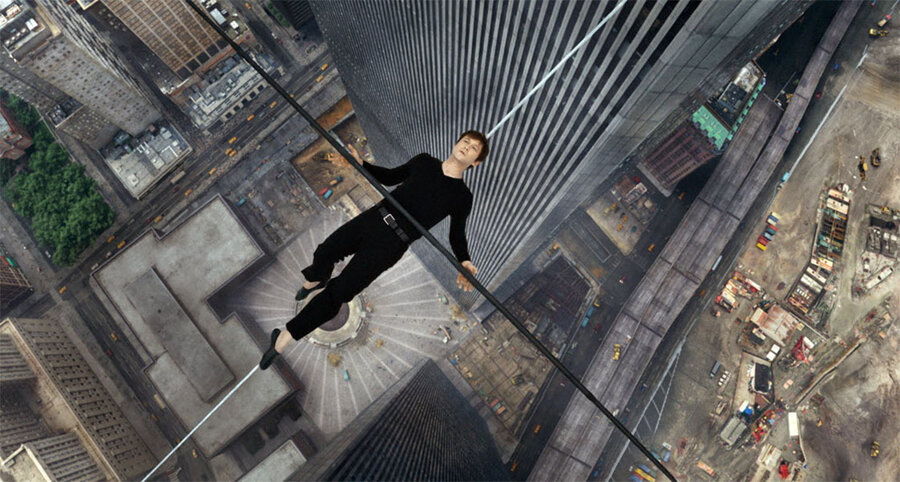'The Walk': How Robert Zemeckis recreated Philippe Petit's World Trade Center walk for the big screen
Loading...
Robert Zemeckis' big, cinematic tale of Philippe Petit's audacious 1974 World Trade Center high-wire stunt is itself a bold balancing act in a lost art.
Mixing big-screen spectacle and an original story about real-life human beings is not the usual recipe in today's reboot-crazed Hollywood. "The Walk," which boasts some of the best 3-D the medium has seen, would be out of place amid the superheroes of summer, just as it stands out among the dour dramas of the fall.
"I so subscribe to the Francois Truffaut quote that a successful movie artistically is a movie that's a perfect blend of truth and spectacle," Zemeckis said in a recent interview. "I do think that's what we go to movies to see."
"The Walk," which opens nationwide Friday, stars Joseph Gordon-Levitt as Petit and recounts the French high-wire artist's famous caper: sneaking to the top of the just-completed Twin Towers to hoist a wire and tiptoe between them.
But the film is also an argument for the magic of movies to ascend to greater heights than a comic-book factory. It's not hard to see "The Walk" as a metaphor for Zemeckis' movies altogether: the story of an individual elevated to dreamy heights of the clouds.
"If you're going to do an original movie that isn't a sequel, you've got to really supply a big cinematic experience," says Tom Rothman, who produced "The Walk" while reviving TriStar Pictures before becoming chairman of the Sony Pictures Entertainment motion picture group.
"Everyone knows there's so much great stuff on television and blah, blah, blah," adds Rothman. "You've got to really give people a reason to get out of their house and go to the cinema and see it on the big screen with a capital B. And that's what this is."
The film has for years been a passion project for the 63-year-old Zemeckis ("Back to the Future," ''Forrest Gump"), one of Hollywood's great illusionists. He spent a decade in digitally animated movies ("The Polar Express," ''A Christmas Carol") before returning to live-action with 2012's "Flight," a character study of an alcoholic pilot (Denzel Washington) that enticed moviegoers with an extraordinary plane crash set-piece – a carrot of special-effects dazzle.
In the time since Zemeckis began developing "The Walk," Petit's stunt was retold in James Marsh's Oscar-winning documentary "Man on Wire." But while Zemeckis grants it's a very good documentary, he notes it's missing one essential thing: Petit's walk.
That's because when Petit made his early morning stroll with a handful of collaborators, it was photographed but not videotaped.
"Philippe was on the wire for 45 minutes and in all of Manhattan, no one could scramble a movie camera in 45 minutes," chuckles Zemeckis. "How times have changed."
The central feat of "The Walk" is its digital recreation of the Towers, along with the vertigo-inducing 3-D sensation of being 110 stories in the air. The dizzying effect — made within a budget of just $35 million – sent some moviegoers rushing to the restroom at the film's New York Film Festival premiere on Saturday.
"My cameraman and my visual effects supervisor and I, we studied what the best way would be to evoke that feeling of vertigo," says Zemeckis. "We really paid attention to where we put the camera, what lenses we used, how we moved the camera, what gave us the most dramatic sensation of height."
Gordon-Levitt spent several days at Petit's home in the Catskills training with the still-passionate 66-year-old Frenchman. Armed with an extensive, minute-by-minute lesson plan, Petit swore Gordon-Levitt would be walking unassisted on a wire within a week – and he was.
The best way Gordon-Levitt could relate to the extreme pressure of a wire-walker was his experience as host of "Saturday Night Live" in 2009, a performance that included a backflip, all live and without a net.
He calls "The Walk" the quintessential Zemeckis film.
"Most of the big spectacular movies that come out of Hollywood, the characters can be a little one-dimensional," says Gordon-Levitt, whom Zemeckis urged to watch films about brilliant, near-crazy icons like "Amadeus" and "Patton." ''So it was a rare treat to get to be in a movie that has such incredible, spectacular visuals, but also has at its core a really intriguing and nuanced human drama."
For Rothman, the challenge of running Sony will be in making big, all-audience originals like "The Walk" – provided, fingers crossed, they succeed.
"It's an endangered species," says Rothman. "An original film that's made for a broad audience with spectacle but isn't based on a comic book and isn't a sequel – there aren't any of those. The business has a terrible time making them now. You can only do it if you really believe the movie's going to turn out really well.
"You need somebody who's as gifted at it as Bob is."







